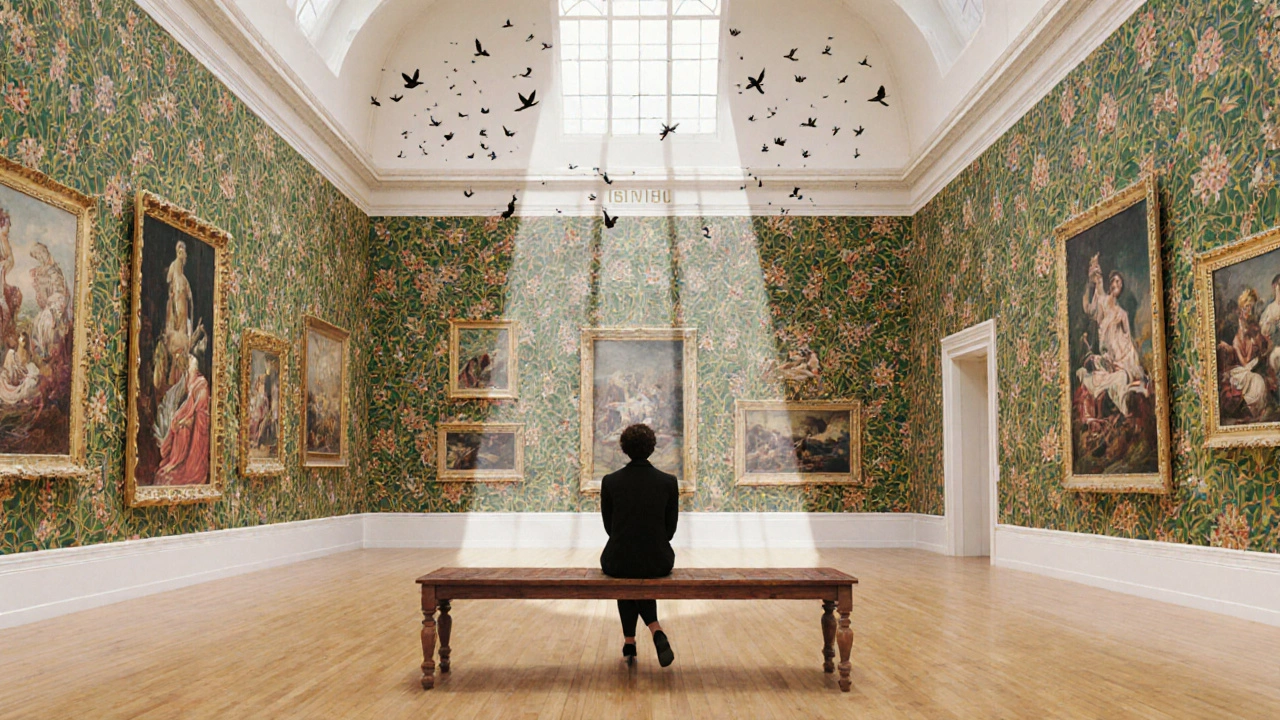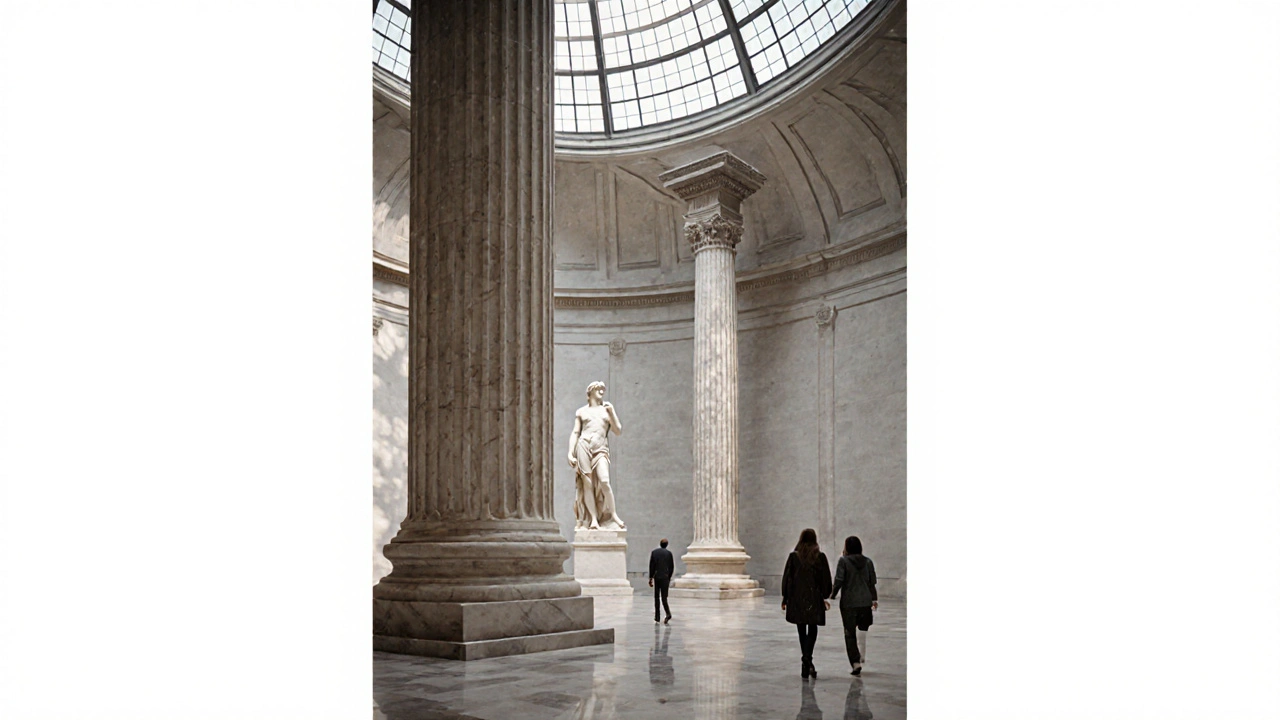The Victoria and Albert Museum isn’t just another London museum. It’s where history, craft, and everyday beauty collide. While the British Museum holds ancient relics and the Tate Modern shows bold modern art, the V&A is where you find the quiet magic in a 17th-century porcelain teacup, a 1920s Art Deco lamp, or a 1980s punk leather jacket. If you’ve ever paused to admire the stitching on a dress, the curve of a chair, or the pattern on wallpaper, this is your place.
What Makes the V&A Different?
Most museums focus on fine art-paintings and sculptures meant to be admired from a distance. The V&A flips that. It celebrates the objects people actually used, lived with, and loved. A hand-carved wooden spoon from 1890? Here. A pair of 1950s high heels worn by a Hollywood star? Also here. A 1970s Apple prototype keyboard? Yes, that’s in the design gallery too.
The museum doesn’t just display things. It tells stories about how things were made, who made them, and why they mattered. You’ll see how industrialization changed furniture design. How colonial trade brought new materials into European homes. How a single textile pattern could spark a global trend.
It’s not just about old things either. The V&A collects today’s design-smartphones, sneakers, even AI-generated fashion. The museum’s current exhibitions include a room dedicated to sustainable fashion from 2023 and a display on how TikTok influencers are reshaping home decor trends.
Must-See Collections
- European Decorative Arts (1500-1800): Walk through rooms that look like royal palaces. Gilded mirrors, intricate marquetry tables, and hand-painted porcelain from China and Japan fill the galleries. The Cast Courts hold full-scale replicas of Michelangelo’s David and Trajan’s Column-yes, you can walk between them.
- British Design (1700-Present): This is where you see how British taste evolved. From Queen Anne’s walnut chairs to Vivienne Westwood’s ripped corsets. The Fashion Gallery rotates every few months, so you’ll always see something new-like the 2024 exhibit on British streetwear’s rise from London’s underground clubs.
- Asian Art and Design: One of the best collections outside Asia. Japanese lacquerware, Chinese silk robes, and Indian carved ivory boxes are displayed with care. Don’t miss the Japanese Tea Room, a full-scale replica built in 1910, where you can sit quietly and feel the stillness.
- Design 1850-Today: This is the heart of modern design. Here you’ll find the first electric kettle (1891), the original Dyson vacuum cleaner (1993), and the first iPhone prototype (2007). The Design: 1900-1950 section shows how war, economics, and new materials shaped everything from radios to refrigerators.
How to Navigate the V&A
The museum is huge-145,000 objects spread over 145 galleries. You can’t see it all in one day. Here’s how to make it work:
- Start with the entrance hall. Look up. The glass dome and mosaic floor are as much a part of the collection as anything else. The Cast Courts are right ahead-don’t skip them.
- Use the free floor plan. Pick one up at the info desk or scan the QR code near the entrance. It highlights key galleries and rest spots.
- Focus on one era or theme. Try the 18th-Century Furniture wing or the Textile Room. Spend an hour deep-diving instead of rushing through ten rooms.
- Check the daily talks. At 2 p.m., curators give free 20-minute tours of rotating exhibits. No booking needed. These are the best way to hear behind-the-scenes stories.
- Visit the shop. It’s not just souvenirs. You’ll find reproductions of historic wallpapers, hand-thrown ceramics, and limited-edition design books. Many items are made by the same craftspeople who restored the originals.

Hidden Gems Most Visitors Miss
Most people stick to the main galleries. But the V&A’s soul lives in the quieter corners:
- The Wallpaper Gallery: A whole room of 19th-century British wallpaper. The patterns are wild-floral vines, mythological scenes, even tiny birds in flight. The museum has over 30,000 pieces, and you can see them all in this one room.
- The Prints and Drawings Study Room: You need to book ahead, but it’s free. Here, you can request to see original sketches by William Morris, Charles Rennie Mackintosh, or Erté. Touch the paper. See the pencil lines. It’s like stepping into the artist’s studio.
- The Photography Archive: Not just portraits. This is where you find 1930s photos of factory workers making ceramics, 1960s shots of London street markets selling lace, and 2010s images of 3D-printed jewelry being made in Hackney.
- The British Galleries (1500-1900): Located on the second floor, this section feels like walking through a historic home. You’ll see a working 1840s kitchen, a Victorian child’s bedroom, and a gentleman’s study with a desk that folds into a bookcase.
When to Go and How to Avoid Crowds
The V&A gets packed on weekends and during school holidays. Here’s how to beat the rush:
- Go on a weekday. Tuesdays and Wednesdays are quietest. The museum opens at 10 a.m. and stays open until 5:45 p.m. (until 10 p.m. on Fridays).
- Visit on Friday nights. The museum stays open late, has live music in the courtyard, and the crowds thin out after 7 p.m. It’s a totally different vibe-calm, moody, and lit with soft spotlights.
- Use the Cromwell Road entrance. Less crowded than the main South Kensington entrance. You’ll still pass the same iconic statue of Queen Victoria.
- Bring a water bottle. There are free water refill stations on Levels 1 and 3. You won’t find a café that doesn’t charge £5 for a bottle of water.
Why Decorative Arts Matter
People often ask: “Why should I care about a teapot from 1750?” The answer is simple: objects shape how we live. A well-designed chair doesn’t just sit in a room-it changes how you sit, how you talk, how you feel. A beautiful mug makes your morning coffee feel like a ritual.
The V&A proves that design isn’t just about looks. It’s about function, culture, and human need. The 1848 Crystal Palace exhibit shows how mass production changed society. The 1980s Postmodern Design gallery shows how rebellion found form in color and shape.
Every object here was once new. Someone chose it. Someone used it. Someone loved it. The V&A keeps those stories alive.
Plan Your Visit
Entry to the V&A is free. You don’t need to book for general admission, but you do need to reserve a time slot for special exhibitions (like the current Design for the Future show). Check their website before you go.
Public transport is easiest: South Kensington tube station (District, Circle, and Piccadilly lines) is a 3-minute walk. Buses 14, 49, 70, 74, 345, 414, and C1 stop nearby.
Don’t rush. The V&A rewards slow looking. Sit on a bench. Look at one object for five minutes. Ask yourself: Who made this? Why? What did it mean to them?
You’ll leave not just with photos, but with a new way of seeing the world around you.
Is entry to the Victoria and Albert Museum free?
Yes, general admission to the V&A is free for everyone. You can walk in anytime during opening hours without a ticket. However, special exhibitions-like temporary shows on fashion, digital design, or historical collections-require a paid ticket. These are clearly marked on the museum’s website and at the entrance.
How long should I spend at the V&A?
You can see the highlights in 2-3 hours, but if you want to really explore, plan for 4-5 hours. The museum has over 145 galleries, and the best way to experience it is by picking one or two themes to focus on-like fashion, ceramics, or furniture. Many visitors return multiple times just to dive deeper into specific collections.
Can I take photos inside the V&A?
Yes, personal photography is allowed in most galleries for non-commercial use. Flash, tripods, and selfie sticks are not permitted. Some special exhibitions may restrict photography-signs will be posted at the entrance. Always check the rules before you start snapping.
Are there guided tours available?
Yes, the V&A offers free daily talks by curators, usually at 2 p.m., lasting about 20 minutes. These are great for understanding the stories behind key pieces. You can also book paid private tours for groups or themed walks-like a focus on Art Deco or Victorian jewelry. Check the website for the current schedule.
Is the V&A family-friendly?
Absolutely. The V&A has a dedicated family trail with activities for kids aged 5-12, including scavenger hunts and drawing stations. The Design: 1900-1950 gallery has interactive touchscreens showing how old appliances worked. There’s also a family-friendly café with high chairs and kid-sized menus. Strollers are welcome everywhere.
Where can I eat at the V&A?
There are several options. The Wright Restaurant on Level 1 offers lunch and afternoon tea with views of the garden. The John Madejski Garden has a kiosk for coffee and snacks. The Grill Room on Level 2 serves sandwiches and pastries. All locations accept cash and card. Outside food is allowed in the garden and designated seating areas.
Next time you’re in London, don’t just visit a museum. Visit a storybook made of objects. The V&A doesn’t just show you design-it shows you how people lived, dreamed, and made the world around them.
